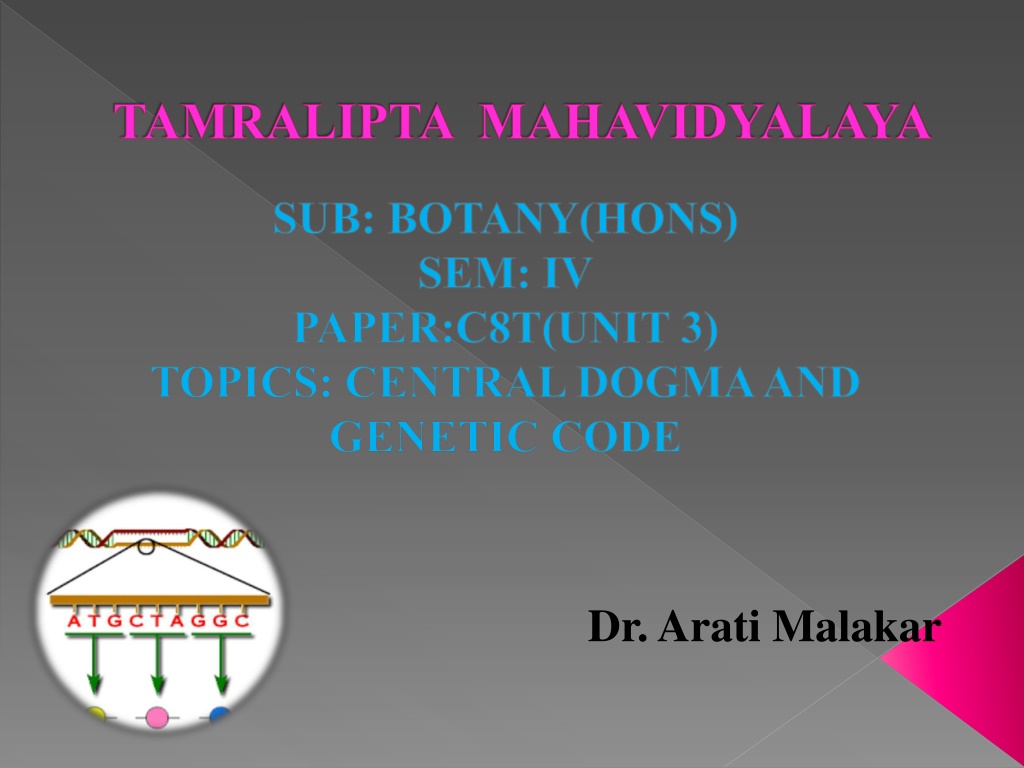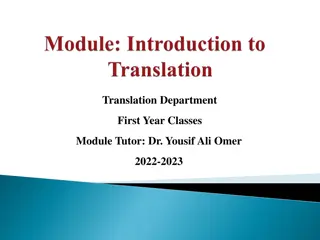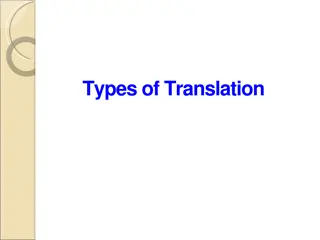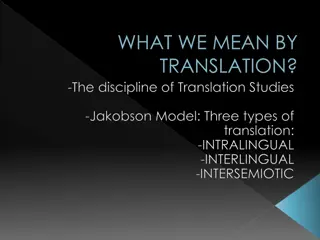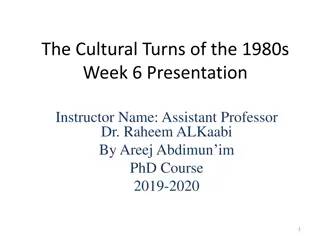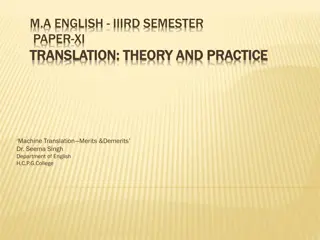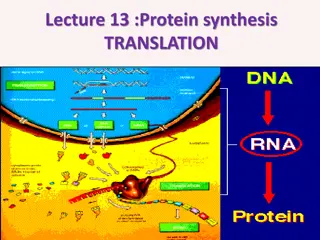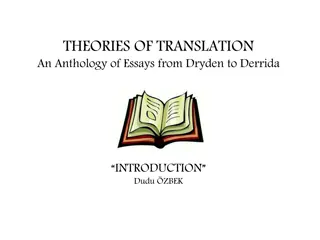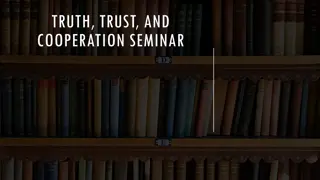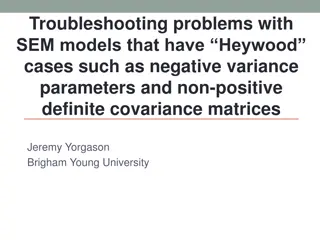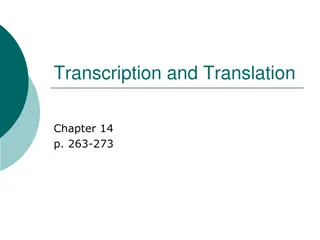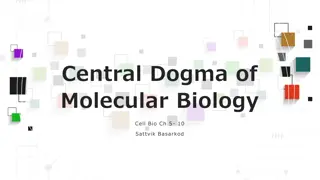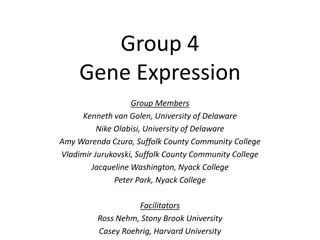The Central Dogma and Genetic Code in Botany
The central dogma in molecular biology explains the flow of genetic information from DNA to RNA to protein through transcription and translation. The genetic code is a set of rules translating nucleotide sequences into amino acids. It consists of codons that specify amino acids, with sense and signal codons playing crucial roles. Explore the significance of genetic code and its types in botany studies.
Download Presentation

Please find below an Image/Link to download the presentation.
The content on the website is provided AS IS for your information and personal use only. It may not be sold, licensed, or shared on other websites without obtaining consent from the author.If you encounter any issues during the download, it is possible that the publisher has removed the file from their server.
You are allowed to download the files provided on this website for personal or commercial use, subject to the condition that they are used lawfully. All files are the property of their respective owners.
The content on the website is provided AS IS for your information and personal use only. It may not be sold, licensed, or shared on other websites without obtaining consent from the author.
E N D
Presentation Transcript
TAMRALIPTA MAHAVIDYALAYA SUB: BOTANY(HONS) SEM: IV PAPER:C8T(UNIT 3) TOPICS: CENTRAL DOGMA AND GENETIC CODE Dr. Arati Malakar
Central Dogma The central dogma of molecular biology describes the two- step process, transcription and translation, by which the information in genes flows into proteins: DNA RNA protein. Transcription is the synthesis of an RNA copy of a segment of DNA. RNA is synthesized by the enzyme RNA polymerase Fig.1: Central Dogma
What is Genetic Code? Genetic code is a dictionary that corresponds with sequence of nucleotides and sequences of amino acids. Genetic code is a set of rules by which information encoded in genetic in material (DNA or RNA sequences) is translated into proteins by living cells. Discovary George Gamow conclude that a three letter code must be employed to encode the 20 amino acids used by living cells to build proteins.
Introduction There are A, G, C and T assemble to the nucleotides found in DNA. They are organized into codon. The collection of codons is called Genetic code. For each amino acids there should be 20 codons. Each codon should have 3 nucleotides to impart specificity to each of the amino acid for a specific codon. 1 nucleotide- 4 combinations. 2 nucleotides- 16 combinations 3 nucleotides- 64 combinations most suited for 20 amino acids Fig.2: The genetic code.
Genetic code can be expressed in a simple table with 64 entries Fig.3: Genetic code and indicating Amino Acids Table
Codon and its type Genetic code is a dictionary consists of Genetic words called CODONS. Each codon consists of three bases(triplet) There are 64 codons. 61 codons code for 20 amino acids in proteins. 3 conons do not code for any amino acids. They are called non sense codon.
Types of codon Sense codon: The codon that code for amino acid called sense codon. Signal codon: Those codons that code for signal during protein synthesis are called signal codons. For example: AUG, UAA, UAG & UGA There are two types of signal codons: Terminating codon Initiating codon Start codon. Stop codon.
Terminating codon: UAA, UAG & UGA are terminating codons or nonsense codons & are often referred to as amber, ochre & opal codos. Initiating codons: AUG is the initiating codon. It codes for the first amino acid is all proteins. At the starting point it codes for methionine in eukaryotic & formylmethionine in prokaryotes.
Anticodon: The base sequences of t RNA which pairs with codon of mRNA during translation is called anticodon. Fig.4: Anticodon on tRNA
Difference between codon and anticodon Codon Anticodon Codon is found on the coding strand of ds DNA & ss mRNA Codons are written in 5 to 3 direction It is complementary to the nucleotide triplet on the DNA It determines the position of amino acids anticodon is found always in tRNA anticodons are usually written in 3 to 5 direction. It is complementary to the codon It brings the specific amino acid by the codon One mRNA contains many codons One tRNA contains one anticodon.
The relationship between codon and anticodon The codons and anticodons have complementary nitrogenous bases, allowing them to base pair. Because the kind of amino acid attached to a tRNA depends on the tRNA's anticodon, the base pairing between the anticodons and codons bring s a specific sequence of amino acids to the ribosomes.
Characteristics of the genetic code Triplet code. Comma less. Non overlapping code. The coding dictionary. Degenerative code. Universally code. Non ambiguous code. Chain initiation code. Chain termination code.
Genetic code is triplet The genetic code is triplet. There are 64 codons. A single amino acid is specified by a sequence of three nucleotides in the mRNA. Due to this triplet nature, it consists of 64 codon. There are 20 amino acid Genetic code is triplet The genetic code is triplet. There are 64 codons and they are coded by 64 codons Fig.4: Genetic code is triplet
Universality: The genetic code is universal AUG is the codon for methionine in mitochondria. The same codon codes for isoleucine in cytoplasm. Non ambiguous: The genetic code is non ambiguous. Thus one codon can not specify more than one amino acid
Non overlapping: One base Cannot participate in the formation of more than one codon. This means that the code is non overlapping. Continuopus Translation: The gene is transcribed & translated continuously from a fixed starting point to a fixed stop codon. Punctuations are not present between the codons.
Degeneracy of genetic code An amino acid can be coded for by more than one codon. This is called degeneracy of genetic code. Fig.6: Degeneracy of genetic code
Wobble Hypothesis Crick postulated the Wobble Hypothesis to account for the degeneracy of genetic code. According this hypothesis, the first two bases of a codon pair accordingly to the normal base pairing rules with the last two bases of anticodon. Base pairing at the third position of a codon is wobble. Fig.7: Wobble Hypothesis
Wobble hypothesis explains degeracy Wobble hypothesis explains the degeneracy of the genetic code i.e. existence of multiple codons for a single amino acids. Although there are 61 codons for amino acids, the number of tRNA is far less( around 40) high is due to wobbling.
Biological significance of degenaracy of the genetic code If the code were not degenerate, 20 codons would designated amino acids and 44 would lead to chain termination The probability of mutating to chain termination could therefore be much higher with a non degenerate code.
Flow of genetic information Fig.8: Flow chart of genetic information.
Clinical Significance Mutation can be well explained using the genetic code Point mutations A. Silent B. Misense C.Nonsense Frame shift Mutation.
Silent mutation Single nucleotide change A to G, same amino acid is incorporated. Mutation goes unnoticed. Missense Mutation Single nucleotide change A to C different amino acid incorporated. Loss of functional capacity of protein. Non sense Mutation Single nucleotide change from C to T, stop codon is generated( In m RNA represented by UAG), premature termination of chain, may be incompatible with life. Frame shift Mutation Insertion or removal of a bases can alter the reading frame with the resultant incorporation of different amino acids.
